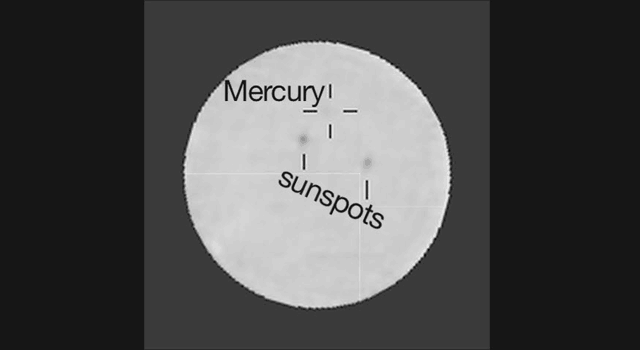https://en.wikipedia.org/wiki/Transit_of_Mercury wrote:
Mercury Passes in Front of the Sun, as Seen From Mars
<<This animated blink comparison shows five different versions of observations that NASA's Curiosity made about one hour apart while Mercury was passing in front of the sun on June 3, 2014. This animated blink comparison shows five versions of observations that NASA's Curiosity made about one hour apart while Mercury was passing in front of the sun on June 3, 2014. Two sunspots, each about the diameter of Earth, also appear, moving much less than Mercury during the hour. June 10, 2014 NASA's Curiosity Mars rover has imaged the planet Mercury passing in front of the sun, visible as a faint darkening that moves across the face of the sun. This is the first transit of the sun by a planet observed from any planet other than Earth, and also the first imaging of Mercury from Mars. Mercury fills only about one-sixth of one pixel as seen from such great distance, so the darkening does not have a distinct shape, but its position follows Mercury's expected path based on orbital calculations. The observation by the telephoto camera of Curiosity's two-eyed Mast Camera instrument is available online. "This is a nod to the relevance of planetary transits to the history of astronomy on Earth," said Mark Lemmon of Texas A&M University, College Station, a member of the Mastcan science team. "Observations of Venus transits were used to measure the size of the solar system, and Mercury transits were used to measure the size of the sun." The observations were made on June 3, 2014, from Curiosity's position inside Gale Crater on Mars. In addition to showing the Mercury transit, the same Mastcam frames show two sunspots approximately the size of Earth. The sunspots move only at the pace of the sun's rotation, much slower than the movement of Mercury.
Mercury and Venus transits are visible more often from Mars than from Earth, and Mars also offers a vantage point for seeing Earth transits. The next of [transits] visible from Mars will be Mercury in April 2015, Venus in August 2030 and Earth in November 2084.>>
APOD: A Mercury Transit Music Video from SDO (2019 Oct 21)
- neufer
- Vacationer at Tralfamadore
- Posts: 18805
- Joined: Mon Jan 21, 2008 1:57 pm
- Location: Alexandria, Virginia
Mercury transiting the Sun as viewed by Curiosity
Art Neuendorffer
- JohnD
- Tea Time, Guv! Cheerio!
- Posts: 1593
- Joined: Wed Feb 16, 2005 2:11 pm
- Location: Lancaster, England
Re: APOD: A Mercury Transit Music Video from SDO (2019 Oct 21)
Thank you, Chris! Which, for me, makes those forerunners all the more heroic!
John
John
-
TheOtherBruce
- Science Officer
- Posts: 102
- Joined: Wed Jul 17, 2019 6:07 pm
Re: APOD: A Mercury Transit Music Video from SDO (2019 Oct 21)
I dunno, the music that came to my mind was whatever was used in the animation "The Inner Life Of The Cell", which did an IMHO mindbogglingly good job of visualising just what goes on inside these tiny squishy thingummies we're all made of.
This universe shipped by weight, not by volume.
Some expansion of the contents may have occurred during shipment.
Some expansion of the contents may have occurred during shipment.
-
Apu
Re: APOD: A Mercury Transit Music Video from SDO (2019 Oct 21)
It's cold outside, there's no kind of atmosphere,
I'm all alone, more or less...
I'm all alone, more or less...
- neufer
- Vacationer at Tralfamadore
- Posts: 18805
- Joined: Mon Jan 21, 2008 1:57 pm
- Location: Alexandria, Virginia
Re: APOD: A Mercury Transit Music Video from SDO (2019 Oct 21)
.
.
.
.
.
.
.
.
.
APOD Robot wrote: ↑Mon Oct 21, 2019 4:11 am
Explanation: The next transit of Mercury
will take place in three weeks: on 2019 November 11.
Art Neuendorffer

